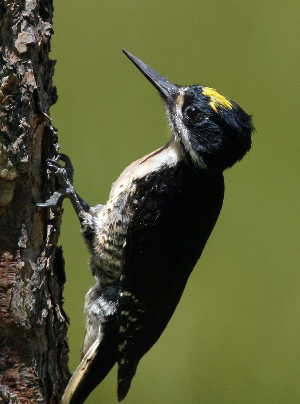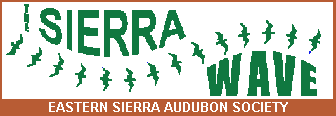
Eastern Sierra Audubon
Sierra Wave Newsletter
Volume 29, Number 2
November-December, 2010
Contents
- Events:
- Features:
- Reports:
- Conservation News:
- Business
December 8 Holiday Potluck Candle-lit Dinner and Program

The Carle's home, Mono Lake,
is crossed by the 38 degree latitude line
The December 8th meeting is also our annual Holiday potluck candle-lit dinner, held at 6 PM in the dining room of the White Mountain Research Station. Do attend as it is a fun event and bring a friend or neighbor. We often run out of food before everyone is served so we ask each attendee to bring a little extra along with a beverage to share. Please bring your own place setting.
The dinner will be followed by a program with slides from Dave and Janet Carle about their travels around the world along the 38th Parallel, seeking water-related environmental and cultural connections. These travel discoveries will become a book published by the University of California Press. They have crossed the U.S., Europe, Turkey, and Korea, and will be in Japan, China, and Turkmenistan in Spring, 2011.
Why the 38th parallel? (from the Carle's blog)
Following a straight line in almost any direction around the globe begins to focus the opportunities for comparisons and connections. Holding to a specific latitude controls for even more variables, which should give deeper meaning to contrasts and similarities.
Why 38°N, specifically? Few other latitudes, north or south, pass through so many states and nations. This is a temperate, middle latitude that has proven conducive to human success. Because of its population concentrations, the Robinson map projection system, now widely used for world maps (adopted by the National Geographic Society in 1988), chose 38 degrees north and 38 degrees south as “standard parallels” – the two lines across the map where size and shape are depicted most accurately (while distortions occur at all other latitudes on maps).
The mean population center of the United States, today, falls near the 38°N latitude. This rather odd statistic identifies the “balance point” where an equal mass of people is found in all directions inside the 48 states. Though this point has gradually been shifting southward and westward, for the last few decades it has stayed very near the 38° line. The 2000 Census located it near Edgar Springs, Missouri, at 37°42’N, 91°48’W. Another way to locate the “center” of the continental United States was used by the author of PrairyErth, William Least Heat-Moon, who wrote about the Kansas county found by diagonal lines drawn between New York City and San Diego and between Seattle and Miami—an intersection that also marks 38°N. There, after decades of debates, a small remnant of the prairie ecosystem was recently protected as the Tallgrass Prairie National Preserve.
One answer to this question is simply that our starting point—our home—is on the 38°N line. While other latitudes must certainly offer meaningful insights, it has been delightful to realize that “our” line coincides with so many intriguing environmental and cultural stories. Without venturing more than a half-degree to either side of the 38th parallel, a long list of historical and cultural sites can be encountered. The fact that this zone—between 37°30’N and 38°30’—can be so tight will make the encounters even more intriguing. Perhaps sharing them will spark others to similarly explore “their” latitude lines.
Our over-arching theme deals with water: wetlands conservation, pollution, domestic supplies, and international tensions. Because 38°N is a middle latitude lying between extremes of climate found farther north and south, successful agriculture there has depended on irrigation canals and reservoir storage. Now, at this point in human history, environmental challenges associated with altered natural water systems are ubiquitous. How those pressures are being dealt with around the world may be the most valuable contrasts and similarities we can uncover by exploring 38°N.
Learn more about their adventure on their blog at Parallel Universe 38°N: The Water Line, and of course, come to the ESAS potluck at White Mountain Research Station on December 8th!
Back to Top
President's Message
Pete Pumphrey
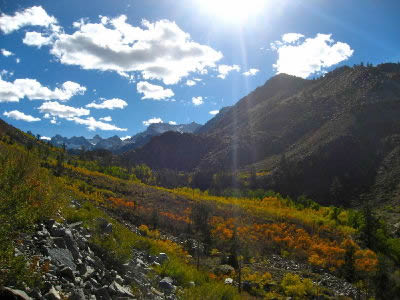
Bishop Creek Above Aspendell, 10/10/10, Maggie Wolfe Riley
“Hopes are shy birds.”
— James Audubon
Is there anything to compare with an Eastern Sierra fall? Even that evil burst of heat could not beat back the early morning bite in the air that signals the change of the seasons. The colors are beginning to appear, the trails seem a bit less dusty and the quality of light shows off the landscape at its best. Happily, the juncos, chickadees and nuthatches were still around to sing for us this week when we visited the Middle Fork of the San Joaquin.
It has been a busy summer for the many folks who have been working on a master plan for Owens Lake. Mike Prather and I have been attending meetings of the main planning body as well as several working groups. I have been very impressed by the energy and commitment that all of the participants have brought to the process. The discussions have been candid and a real learning process for me. There have been disagreements, but we have been able to continue to move forward by actively seeking ways to find agreement. You can learn more about what is happening in the process by going to https://owenslakebed.pubspsvr.com. By the way, special thanks to California Audubon and Andrea Jones for an amazing amount of assistance and support for the lakebed over the past four years.
Speaking of websites, keep up with the Eastern Sierra Audubon Society on this site. Look for information about upcoming programs, the Christmas Bird Count and annual Birdathon, the chapter’s Christmas potluck and a backyard birding and wildlife gardening program coming up in the spring. As always, take some time to get out and enjoy our incredible home and its autumn and winter birds.
Back to Top
Features
Are You Ready for Winter?
Tom & Jo Heindel
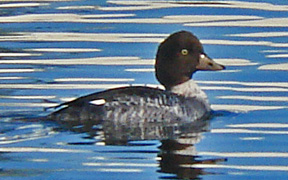
Common Goldeneye, photo by Tom Heindel
No, we are not asking if the storm windows are up, the kerosene tank filled, or the firewood stacked by the backdoor. We are referring to your preparation for the arrival of our winter bird visitors, some of which you have not seen in almost a year!
Bird distribution is a dynamic phenomenon that varies from year to year and season to season. As we have said before, winter is the least predictable of all seasons. Some years a certain species may be relatively common followed by other winters when few or none are found. Some of the birds that visit us may come down from the surrounding nearby mountains while others are from far to the north. They are all at the mercy of habitat conditions, food availability, and perhaps population levels as they make the same trek their species has for eons.

Ferruginous Hawk, photo by Debby Parker
The most accomplished birders spend time at home doing homework…when it is too dark to bird outside! When asked about their general approach to bird identification, they respond that before each season they spend their evenings re-reading the field guides to brush up on how to distinguish the species that will soon be arriving. Even after decades, they still review the marks so that they will be ready in the field. Rare or unusual species almost never get away from them because they know in advance what they have to see to insure a correct identification. It is this constant re-education and review that takes ordinary people and makes them extraordinary birders.
There are fewer bird species in the Eastern Sierra during winter than at any other time of the year. This makes the task a manageable one. Most of our winter birds are residents that we see all year such as Mountain Chickadees, Steller’s Jays, Red-winged Blackbirds, House Finches, etc. Most of the flycatchers, swallows, vireos, warblers, orioles, and other bug chasers are in Mexico, Central or South America where there is an abundance of food. 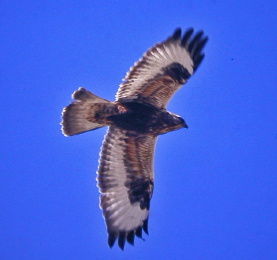
Rough-legged Hawk, photo by Tom Heindel
For many species that remain, the males are bright and beautiful and still easy to identify while the females continue in various drab plumages and challenge us.
The first task is to make a list of species that are winter visitors and see what other species are similar that you might confuse in the field. We are making your task a little easier by providing a starter list for you! Male Common and Barrow’s Goldeneyes are easy to identify, if they are close enough to see the face well, but females require close looks at specific features. Greater and Lesser Scaup are superficially similar but learn what to look for and hope that they fly or stretch their wings! Study the loons – Common, Pacific, and Red-throated are regular in winter but the Yellow-billed is yet to be reliably reported from Inyo County because previous observers were unprepared. Compare dark morph Ferruginous with dark morph Rough-legged Hawks. The light morph birds are relatively easy to identify but the dark morph birds can be difficult. Search for pale gulls and see if you can find a Glaucous or Glaucous-winged Gull. Loggerhead Shrikes are resident but prepare yourself to check each shrike carefully so a Northern Shrike does not get away from you. Bluebirds add badly needed color to the winter palette but females are somewhat similar so know what to look for…besides who their travelling companions are! 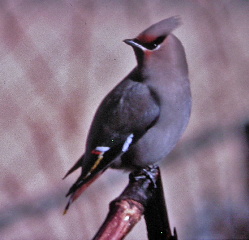
Bohemian Waxwing, photo by Tom Heindel
Cedar Waxwings delight many at pyracantha bushes but check the undertail coverts of all you see in winter so you don’t let a Bohemian Waxwing slip by your binoculars. American Tree Sparrows, Rusty Blackbirds, Black Rosy-Finches, and all four species of Longspurs can be on our winter menu as well.
The rest is up to you! If you have a camera, take it with you so you can photograph a bird that you are unfamiliar with, in order to compare your picture with your resources back home. And remember the oft repeated adage: Success occurs when preparation meets with opportunity. The opportunities will be arriving soon and your success is in your hands!
View Slideshow of Birds
Back to Top
For the Birds:
Wintertime Suet Mixture
From Debby Parker
I thought I'd try to make a suet cake for the birds that visit my backyard. I did some research on how to attract birds and came up with this recipe:
Put mixture below in large bowl (substituting other seeds is fine):
- Millet seed approx. 3-4 cups
- Pumpkin seeds without hulls
- Raw sunflower seeds
- Sesame seeds
- Raisins
Heat up "All Purpose Whipped Shortening" to liquid and pour about 2 cups over the birdseed mix. Then pour the whole mixture into a milk carton or foil-lined carton. The mixture needs to "set-up" so it will “pop-out” easily to put into your suet holder.
So far it's been a big backyard hit. The White-crowned Sparrows enjoy this. It’s easy to do and helps to keep the birds "fueled up" with winter weather coming.
Back to Top
Events
Make Tracks to these Upcoming Field Trips!
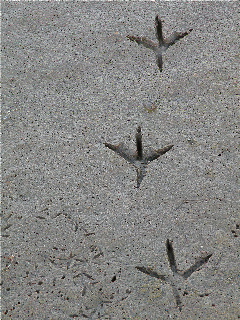
Bird Tracks, photo by Michael Prather
Saturday, November 6: McNally Canal Birding
Do wintering buteos such as Ferruginous and Rough-legged Hawks still hang out near McNally? Sparrows and wrens are assured. Green Heron, Northern Shrike and various falcons have been observed.
The morning walk convenes at 8:00 a.m. near the point where the Silver Canyon Road crosses the canal just east of Laws. Bring liquids, snacks, warm clothes and binoculars. Spotting scopes will be helpful. We'll take a look at nearby Farmer's Pond, too. For more information contact leader Larry Nahm at 872-4125.
Saturday, November 27: Pleasant Valley Reservoir Birding
Have the mergansers, teal, scaup and goldeneye taken winter residence? Can a Canyon Wren cascade its haunting call at this time of year? We'll walk along the lake from its northern end and cover perhaps three level miles round trip. A short detour may be made to one of the inflowing creeks.
Meet at 8:30 a.m. at the power station just north of the reservoir. Bring liquids, snacks, warm clothes, binoculars, spotting scopes. Trip will end in the noon hour. Leader Larry Nahm can be reached at 872-4125.
Saturday, December 4, 2010: Winter Birding at Crowley Reservoir
Trip leader: Jon Dunn. This is a great chance to see Bald Eagles, geese, and wintering ducks. Meet at the Green Church at 9:00 AM. Bring binoculars, scopes, water, lunch, and wear clothes for the potentially cold weather. If the weather is bad, meet in Bishop at the Y for birding at Tinemaha Reservoir. Contact Larry or Carolyn for more info at 872-4125.
Back to Top
The 29th Annual Bishop Christmas Bird Count
Saturday, December 18th, 2010
The CBC is an important citizen-science effort to census all birds in the Bishop area. Results show long term population trends and shifting demographics. Plus, it's a lot of fun! There's always a chance to see a rarity such as those in 2009: "Red" Fox Sparrow, Greater White-fronted Geese, and "Bewick's" Tundra Swan. All skill levels are invited to participate. Please sign up as soon as possible by contacting Chris Howard at chris93514@gmail.com.
Back to Top
Eastern Sierra Audubon Society
BIRD-A-THON - Saturday, December 18, 2010
Eastern Sierra Audubon has shifted the date of its annual Bird-a-Thon fundraising effort to coincide with the Christmas Bird Count. Anyone can participate in the count which is a major effort to monitor the numbers and distribution of bird species throughout the Western Hemisphere. Simply put, the Christmas Bird Count is citizen science in action.
When you participate or sponsor a participant, you play a vital role in keeping the Eastern Sierra Audubon chapter alive and well. The Bird-a-Thon is the chapter's most important fundraiser.
Bird-a-Thon donations fund the "Birds in the Classroom" program which teaches elementary school students to appreciate the importance of the natural environment and our bird resources. We hope to continue to add schools to this program with your help and support. Funds are also needed for ESAS's other educational programs, outreach, field trips and to maintain the website and newsletter.
Even a donation of $10 or $20 would go far to help us in our mission. Please join us in support of Eastern Sierra Audubon by making your Bird-a-Thon pledge:
You can support this great event with a flat donation or choose a sponsorship level.
All donors receive a detailed summary of the Bird-a-thon.
To Donate,
- Print and mail the pledge form, or,
- Send an email* with your pledge by clicking on one of the levels listed below:
*If clicking the links above doesn't generate an email for you, just send an email with your pledge amount to mprather@lonepinetv.com.
Please make checks payable to Eastern Sierra Audubon Society.
Please mail checks to:
Bird-A-Thon
Drawer
D
Lone Pine, CA 93545
Contact Mike Prather with questions at mprather@lonepinetv.com.
Back to Top
Reports
A Visit from John Muir Laws
Serena Dennis
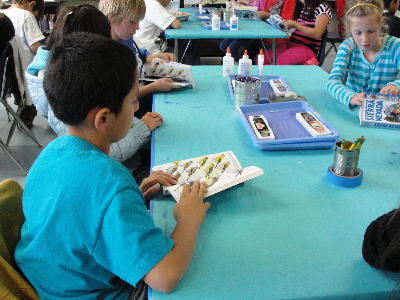
Children at Bishop Elementary learn how to identify birds with the John Muir Laws Field Guide to the Sierra Nevada.
“Pretend you are walking through a forest. Ahead of you on the trail, in a tree you suddenly spy a yellow bird. One, two, three, go!” said John Muir Laws, as I walked into Mrs. Howard's art class at Bishop Elementary. Each child in the class had a Field Guide to the Sierra Nevada, and was furiously flipping through the pages. Arms shot in the air, and everyone yelled out, “I've got it, I've got it!”
Naturalist and educator, John Muir Laws, was in Bishop on an Eastern Sierra tour, stopping at elementary schools from Alpine to Inyo County. Each school he visited received twenty five copies of the Sierra Nevada guide. Hundreds of youth were inspired by his storytelling and art lessons. Mrs. Howard, art teacher at Bishop Elementary, said, “The children's level of involvement was extremely high. This means they were engaged and focused on John and what he was demonstrating even when there were fifty children in the room! They loved it. John shared with them that he is dyslexic and had a hard time in school due to the difficulty he experienced in learning how to read. Nonetheless, he is a successful, published artist and author. What a great example for all students, regardless of their success in academic settings.”
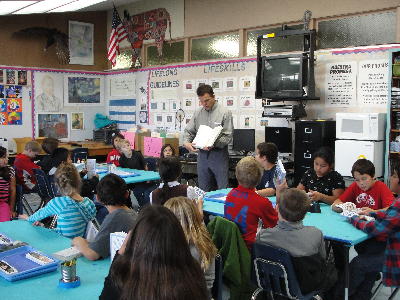
John Muir Laws shares over ten years of sketch books, saying,
“The more you draw, the better you get at it. Practice, practice, practice.”
John Muir Laws' visit was sponsored by the Eastern Sierra Audubon Society, with support from Sorenson's Resort and the Sierra Nevada Conservancy. In addition to visiting the schools, John Muir Laws presented at ESAS's October Program, and taught a one day drawing class as a fundraiser to support the Laws Historic Railroad Musuem and Eastern Sierra Audubon Society.
Eastern Sierra Audubon Society would like to thank John Muir Laws for traveling to the Eastern Sierra, and touching so many young children's imaginations.
Editor's Note: If you missed Jack Laws' presentation or drawing class, you can see some of his ideas and art techniques, and learn more about his books on his website: www.johnmuirlaws.com
Back to Top
Field Trip Report - Rock Creek, October 24, 2010
Undaunted by steadily falling rain, 40 degree temperatures and howling winds, five outdoor enthusiasts including trip leaders Claus Engelhardt and Bill Mitchel walked from the Sno-Park on upper Rock Creek to the small lake just below Rock Creek Lake. In spite of the elements, there was much to be seen as we walked by trees and plants glistening from drops of rain. Many of the leaves both on and off the trees and plants were still sporting their fall colors of yellow, gold and orange which were further enhanced by the raindrops. Birds, on the other hand, made themselves somewhat scarce although we compiled a respectable list of sightings. As expected, there were several raucous Clarkʼs Nutcrackers flying among the trees, a lone Stellerʼs Jay making sure it didnʼt go unnoticed and an occasional Townsendʼs Solitaire calling from a treetop. We found Mountain Chickadees clustered in a group of Lodgepole Pines and an Oregon Junco. The highlight of the day was an American Dipper feeding in the creek. After hearing a few Brown Creepers, one was sighted in a tree and at the end of our walk we found Common Ravens and Pinion Jays.
by Bill Mitchel
Back to Top
Eastern Sierra Bird Sightings
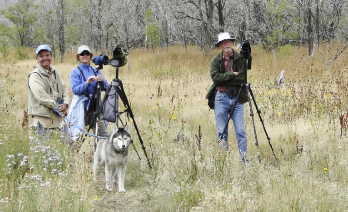
Former ESAS President Jim Parker and Current Board Members Kathy Duvall and Bill Mitchel. Oh, and Smokey!
If you aren't in the Eastern Sierra Birds Google Group, you are missing lots of great photos and descriptions of bird sightings around the area. Here are a few recent (September and October) highlights that had photos - click on any of the links for a slideshow:
Scarlet Tanager, Golden-winged Warbler, Bullock's Oriole, Lawrence's Goldfinch, Lazuli Bunting, Calliope Hummingbird, Rose-breasted Grosbeak, Canada Warbler, and White-tailed Ptarmigan.Black-backed Woodpecker
To join the group and get email updates about bird sightings in the eastern Sierra (or to share your own), go to the group page and click "apply for group membership" in the right hand column. You can edit your email settings after you are a member by clicking "edit my membership," where you can choose from getting each email as it arrives (I recommend starting here, and if it is too much, scale down), or getting a digest, abridged summary, or no email (you would need to check the group online for updates). The ESAS website also has a feed of recent sightings from the group at esaudubon.org/birds/.
Back to Top
Conservation News
Groups seeks protection
for Sierra’s 3-toed woodpecker
The Sacramento Bee
Matt Weiser
10/17/2010
The Black-backed Woodpecker, a native of the Sierra Nevada, has just three toes, a yen for burned trees, and tremendous potential to shake up California logging rules.
Environmental groups recently filed a petition to protect the woodpecker under the state Endangered Species Act. The Center for Biological Diversity and the John Muir Project at Earth Island Institute say the species may go extinct because California doesn't have enough burned forests, the bird's preferred habitat.
If the petition succeeds, private forest owners who experience a fire could have a harder time harvesting burned trees to produce lumber, a practice known as salvage logging.
California currently allows salvage logging under streamlined regulations so property owners can harvest the wood before it rots.
The environmental groups argue this deprives the black-backed woodpecker of essential habitat. The bird prefers to nest in burned trees, and feeds on insects that attack trees after a fire.
Further, they argue, the woodpecker is a feathered icon for a whole ecosystem that revolves around burned forests, which play a vital role in the normal life cycle of California forests.
That cycle was interrupted by a century of misguided fire suppression, and now, they contend, by salvage logging.
"It is the sole bellwether species for an entire ecosystem," said Chad Hanson, executive director of the John Muir Project. "The current management is to allow complete and immediate removal and destruction of Black-backed Woodpecker habitat."
More burned trees need to stay in the forest and rot, Hanson said, as habitat for the woodpecker and other wildlife. Those trees also nourish the soil, prevent erosion and protect water quality.
Bob Mion, communications director at the California Forestry Association, said protecting burned trees would be a hardship on private property owners. They need salvage logging to recover some of the value lost in a forest fire.
Read the full article here.
(Reprinted from Sierra Nevada Alliance Weekly 10/20/10)
Back to Top
Prop 21 is for the Birds!
California State Parks provide critical habitat for birds
Birds rely not just on habitat for survival, but also park conservation programs
With voters set to decide Nov. 2 on a ballot measure to approve new funding for California State Parks, representatives of Audubon California today noted that parks provide critical habitat for birds. A recent study of California's Important Bird Areas found that 50 were contained wholly or in part within state parks. A full 79 California State Park units touched Important Bird Areas.
There are 145 Audubon Important Bird Areas in California that have been selected as part of a global effort to identify essential habitat for breeding, wintering, and migrating birds.
"It shouldn't come as any surprise that these wonderful natural places that we've set aside and protected for our own enjoyment have also turned out to be important places for birds as well," said Graham Chisholm, executive director of Audubon California. "Our state parks are a critical part of California's natural infrastructure."
Examples of the vital role of state parks in bird conservation can be found up and down California. Benicia State Recreation Area contains some of the last pristine tidal marsh habitat in San Francisco Bay which species like the Black Rail and the Endangered California Clapper Rail depend on for survival. State parks in the Big Sur area provide important foraging habitat for the Endangered California Condor. Chino Hills State Park in Southern California provides valuable habitat for the Threatened California Gnatcatcher and the Coastal Cactus Wren, a species of special concern.
"In many cases, it's not just the habitat that makes California State Parks so important for birds," added Chisholm. "It's the conservation and restoration work being done on these properties as well."
A good example is the Western Snowy Plover, a sparrow-sized shorebird that has been listed as Threatened under the Endangered Species Act since 1993. California beaches provide essential breeding and wintering habitat for the Western Snowy Plover, and this places a premium on beaches that are publicly protected and managed. Since the listing, California State Parks has played a key role in Western Snowy Plover conservation, so much so that it is difficult to imagine the bird's survival without the agency's contribution. At breeding sites such as Morro Bay State Beach and Silver Strand State Beach (San Diego), park staff fences off the sites and educates the public about the bird's plight. Staff also conducts important habitat restoration and maintenance, monitors the nests, and collects vital breeding data.
The Marbled Murrelet is another Threatened bird that relies on California State Parks for its existence. Ever since its nests were discovered at Big Basin Redwoods State Park in the Santa Cruz Mountains, state park personnel have taken steps to protect the old growth canopy at the park, keep people away from nesting sites, and maintain the landscape to reduce jay and raven populations from predating the nests.
The intersection of Audubon Important Bird Areas and California State Parks is just one of several reasons that Audubon California supports Proposition 21, which will create a dedicated funding stream for parks. Another compelling reason is the invaluable role that California State Parks play in connecting the state's children and families to the natural world.
"Our State Parks offer numerous opportunities for children and families to learn about birds and wildlife and, in many instances, make that first connection to nature that lasts a lifetime," said Chisholm. "We can't continue to play budgetary games with one of the state's most important resources."
For more information on the initiative and to view current supporters, please visit www.yesforstateparks.com.
Also see Audubon California's 50 reasons to vote for Proposition 21!
Back to Top
Support parks and wildlife by voting YES on Prop. 21
Californians have a deep connection to their state parks. These are places where many of us camped, hiked, fished, or surfed for the first time -- and millions of us frequently return to these great outdoor spaces to experience nature firsthand. Like many of you, I’ve been saddened watching these invaluable sites threatened each year with closure, and seeing the damage done by reduced hours, deferred maintenance, and program cuts. Moreover, these cuts also threaten to degrade some of the state’s best habitats for birds and wildlife. That is why Audubon California is a major supporter of Proposition 21, which will create a dedicated funding source for our parks and ensure that they are there for future generations of Californians to enjoy. I encourage you to learn more about the initiative and vote Yes on Proposition 21.
Graham Chisholm
Executive Director, Audubon California
Back to Top
How You Can Help ESAS: 3 R's
Renew your membership (or join)! The money from your membership dues is what helps us bring great evening programs, special events, educational programs, trips, this website, and more to the community - we need your support!
Recycle at Manor Market and tell them to donate the money to Eastern Sierra Audubon.
Repeat! Spread the word about programs and events, encourage others to join and participate.
And a couple of P's: Participate in or Pledge money to our annual Birdathon Fundraiser!
Back to Top
Message from the Editor
How do you like the new web formatted newsletter? This allows us to integrate the full newsletter more effectively with the beautiful email newsletter. You can still print the newsletter, if you prefer (on recycled or re-used scrap paper, of course!), but this format should save not only paper, but lots of energy in terms of printing and mailing the newsletters, and we hope you enjoy being able to jump directly to specific sections from the contents or search for keywords (click "control F" on a PC or "command F" on a Mac).
We hope to have the same great content, supplied by our amazing members... and speaking of that, if you have any ideas about articles you'd like to see, or better yet, if you have anything to share for newsletter publication, whether an article, a news item, update, correction, poem, essay, artwork, photo, field trip report, neat birding experience, letter, etc, please send it, along with any comments or suggestions, to maggiewolfe@gmail.com. We'd love to hear from you!
Please send any timely items to arrive before the first of the month, so they can be included in the email update, and the next official newsletter will be January/February 2011, so send submissions to arrive by the last week in December at the latest. We will try to send out email updates on the first of every month to include any reminders or timely articles for that month.
Thanks for reading, and happy birding!
Maggie Wolfe Riley, Newsletter Editor
Back to Top
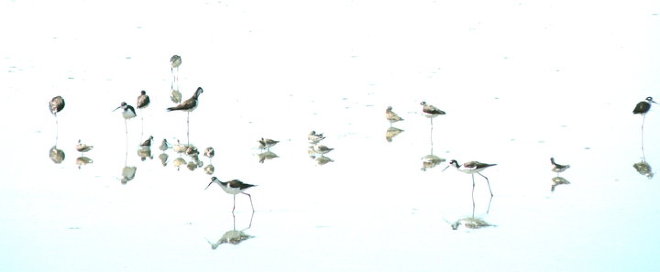
Owens Lake Shorebirds, photo by Mike Prather













